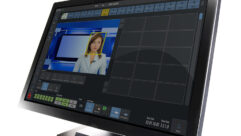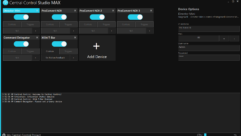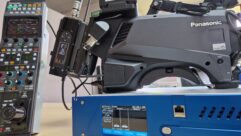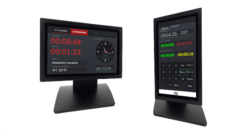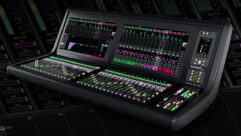
In Control
The high end of the residential market has given rise to sophisticated whole-house automation systems that do everything from controlling a home theater to turning on the lawn sprinklers when that door-to-door solicitor just won’t go away. But the kinds of control systems being designed for these settings don’t offer many lessons for corporations, universities, or other players in the traditional pro AV space.
“Don’t make the buttons smaller than the average person’s fingers.”From pristine to productive
“Assume the user is right handed.”
“Never keep the general waiting.”
“Never let an engineer design a touchscreen.” Any list of “commandments” for creating a successful AV system user interface would probably include basic, almost-obvious, and probably arguable propositions like these.
Simplicity and clarity, after all, are perennial values. The problem is, those values can be hard to realize in an environment offering more options all the time — more components to control, more metrics to adjust, and more ways to configure and operate a system.
The high end of the residential market has given rise to sophisticated whole-house automation systems that do everything from controlling a home theater to turning on the lawn sprinklers when that door-to-door solicitor just won’t go away. But the kinds of control systems being designed for these settings don’t offer many lessons for corporations, universities, or other players in the traditional pro AV space.
“A residential designer designs a system for eight or 10 people to use, but a commercial guy may design for 8,000 or 10,000,” says Jim Pope of Professional Videographics in Denver. Any time a system must be designed for a large number of users whose skills are unknown, Pope adds, “things can’t be confusing.”
The goal of an ideal interface design in pro AV is often to deliver a system that anyone can walk into a room and use — without delays, confusion, or extensive navigation.
“We have a lot of global clients, and we have been tasked with making a consistent look for a client with hundreds of touch points all over the world,” says Christopher Maione, partner in Costello Maione Schuch Inc., New York.
Even in a more geographically limited implementation, facilities can have large numbers of different users at different times, with different objectives. While not knowing who the eventual end-user is — or what he/she will want — the interface designer still has to make it easy for that user to have a successful experience.
The designer must achieve this goal despite the proliferation of controllable components — screens, window shades, lights, projectors, microphones, speakers, DVD players, cable TV, computer inputs, Internet connections, and more — and often in the face of the client’s powerful urge to complicate matters. The battleground on which this conflict plays out these days is almost always a touchscreen.
Having advanced dramatically in recent years, today’s systems can locate the lightest touch of a user’s fingertip anywhere on the screen’s surface, track the finger’s movements all over the screen, and translate slight increases of finger pressure into commands. The screen itself, though, just represents the hardware component of a system in which software does most of the heavy lifting. Moreover, even though many users and facilities have common needs and capabilities, nearly every user interface must be individually designed. There is no “plain vanilla” interface that will work right out of the box.
“When our devices leave our factory, they are totally blank,” says Gus Garramuno, senior designer of Graphical User Interfaces at Crestron, headquartered in Rockleigh, NJ.
Dustin Clinton of Visual Commands Inc. in Bellevue, WA, agrees: “AMX and Crestron don’t come off the shelf with any kind of programming at all. Every job is custom to some degree.”
The designer’s job is to listen to the client, figure out what functions the client needs to control most often and most easily, and create an interface that provides the simplest access to those controls. This is where that empty, pristine touchscreen begins to lose its purity. Designers often start out with an opening screen with a simple prompt like, “What do you want to do?” The user then can select an audioconference, videoconference, computer display, or other basic activity.
Each choice, though, branches off of the decision tree, and as screens pass before the user’s eyes, the choices multiply, buttons propagate like bunnies, and confusion looms.
The key is “to try to make it as intuitive as possible,” Garramuno says. “Trying to place everything on the touchpanel to make it accessible winds up cluttering the screen and makes it more confusing and more difficult to process.”
One enemy of simplicity is the sheer number and variety of things that can be controlled. This diversity often excites the more technologically savvy, but can lead to designs that stump the everyday user.
“Engineers should not be allowed to design touchscreens,” says Maione, who adds, “I’m an engineer myself, by degree. We have an appreciation for the technical aspects. Give me the advanced screen, put every button I tell you to put on the advanced screen, but that’s not what the end-user needs to touch. A lot of times the engineer thinks that because it’s in there, you have to give it to the user, and that’s the worst thing in the world.”
The Future of AV Interfaces
AV system controls and end-user interfaces have made a great deal of progress in recent years, but some industry players think the future may bring even more striking enhancements. What are the most likely changes on the horizon?
Voice recognition is one hot area. Computers can already be trained to recognize a user’s voice and accept spoken commands. Extending this power to AV controls could pay off, in particular, for users with disabilities. But a typical AV use is more complicated, says Christopher Maione, partner in Costello Maione Schuch Inc., New York.
Voice commands to computer systems currently only work “with people whose voices have been learned by the system,” he says.
Creating a system that will recognize and respond to any voice, in the sound-cluttered environment of a conference room, will be a challenge.
“Voice recognition just isn’t quite there yet,” says Jim Pope of Professional Videographics in Denver. “It’s close, but close doesn’t cut it in the corporate realm.”
Radio Frequency Identification tags (RFID) offer another avenue. An RFID built into a user’s employee badge could enable a room system to recognize a user immediately and automatically call up presets and other user-specific content. “RFID is going to be a huge player,” says Joseph Kessler, multimedia development manager at AMX, headquartered in Richardson, TX. “You can personalize people’s experiences in rooms, because you’ll know who the person is.”
David Silberstein of Crestron, headquartered in Rockleigh, NJ, sees closer links between AV room controls and a building’s management system. “The standard building management system doesn’t have access to the scheduled use of particular spaces,” he notes.
By connecting the room’s system to the building’s networks, the building can adjust heat and air conditioning, for instance, to provide a comfortable meeting environment while not running as much when the room is idle.
Instead, Maione says, user interface design should be guided by what he calls the three-click rule. “You have to be able to get to anything you want to do in less than three button pushes, not counting turning the system on,” he says. “Ideally, it’s one button; most of the time it’s two.”
Crafting that kind of system, of course, requires plenty of client input and thinking time to get the navigational scheme just right. Client input, in turn, can often turn into “enemy No. 2.”
At Richardson, TX-based AMX, Robert Noble, vice president of Product management, notes that “we usually get involved one way or another” in the projects of integrators and designers using AMX systems. “We have integrators asking for guidance, or they get in over their heads, and we have to throw them a lifeline. A lot of times, it comes down to managing the end-user. Can you say no? Or do you just keep saying yes, and the aggressive end-user keeps wanting more and more, until finally it just doesn’t work.”
It’s important for integrators and designers to distinguish between the desires of the client’s “power users” and those of the people who must use the system every day. Often, integrators also say, there are whole areas of control that everyday users shouldn’t be allowed to access.
The solution is generally to provide access to as much control as the most avid techie could want, perhaps in a password-protected “advanced” area, while keeping these buttons away from the fingers of those who don’t need that level of access.
Dennis Banks, sales manager at Audio Communications Consultants in Memphis, TN, reports he used Biamp’s DaVinci in fashioning user interfaces for the new Shreveport, LA, convention center. Accessing and controlling audio DSP systems can be more complex than controlling hardware devices, he notes. DSP offers an ideal example of a software environment with a multitude of things the user could control, but only a few that he or she really needs to control.
“DaVinci enables the user to control the Audia (DSP) without letting him actually get into the Audia,” Banks says.
The interface also allows resizing, color changing, and other manipulation of onscreen controls —such as assigning different color schemes to controls for different parts of the large Shreveport building “so users could know at a glance which area they were controlling,” Banks says.
Pope often encounters installs with even more stringent access control requirements, because he does extensive work for military clients. In these cases, it’s equally important to protect sensitive information and deliver an easy-to-use, responsive interface.
It’s an age-old AV axiom, of course: That systems must be simple enough for the boss to use. “The two big rules,” Pope says of his military customers, “are never keep the general waiting, and never embarrass the general.”
Maione and others say the best interfaces are designed by graphic artists with an understanding of ergonomics. The look of the touchscreen should also be simple and clean, experts say, but once again, that’s an uphill battle. Many designers adopt corporate colors for their designs and include the client’s logo.
Screen layout should respond to ergonomic factors, too. “Assume the person is right handed,” says Maione, who is a southpaw himself, although the great majority of people — an estimated 85 percent — are right handers.
The more frequently used buttons should be in the upper part of the screen, so that they aren’t obscured by the user’s hand reaching for other controls. Keeping most of the screen visible can also be a reason to put the key buttons at the bottom, Pope maintains.
“Everything gets customized,” Banks says.“Once you get to know the people who are going to use the system, you often will go back in and re-adjust the system for them, as you get more comfortable with what their ability is.”
Dashboard for Controls Update
A person can sit down at any computer running Windows XP Professional and know what to expect. The basic tools will be in the same places, files will open in familiar ways, and the same commands that worked on his home computer work on the road. Why shouldn’t AV system interfaces be the same way?
Creating a consistent look and feel for end-user interfaces was the goal of the “Dashboard for Controls” initiative implemented through InfoComm International over the last four years. The project subcommittee has produced a “Design Guide” and a “Design Reference” document — both of which can be downloaded at www.infocomm.org/dashboard. Former Chair Greg Bronson of Cornell University says the emphasis has now shifted from developing the design guidelines to promoting their broader use.
“Right now, we don’t know exactly where it’s going to go,” Bronson says. “First, we want to maintain the focus of educating the end-user as to what is possible with the dashboard guidelines. Then, let them drive the demand,” he adds, anticipating that users will press their designers and integrators for interfaces that reflect the new guidelines.
Still, Bronson and others stress that the new documents are guidelines and not standards. “InfoComm isn’t a standards writing body, and doesn’t want to be,” says David Silberstein of Crestron. He believes it would be dauntingly expensive to implement a real industry standards program similar to those administered by the American National Standards Institute (ANSI). “Yet, they did want to create some guidelines that the AV community can use to get going.”
Bronson thinks many integrators have “immediately seized on it as a great value-add.”
Providing interfaces consistent with dashboard guidelines could be a competitive advantage, he says. However, people have started saying their products are dashboard-compliant, Bronson says, “but we have no metric for saying whether they are. We have avoided using words like ‘compliant’.”
In the near future, the Dashboard for Controls subcommittee will focus on expanding its website, building new alliances to promote the guidelines, and extending educational efforts into end-user communities, Bronson says.
Banks cites the arrival of IP networks as one of the biggest changes in the control and interface arena in recent years. With IP-addressable components, monitoring and troubleshooting a system is now easier than ever.
A modern AV system can include components from dozens of manufacturers, and the makers of control systems haven’t always had an easy time keeping up with new products. Today, Crestron spends a lot of time working with vendors of everything from projectors to loudspeakers — to ensure the products are compatible.
“For years, every time a projector came out, it had totally different controls,” says David Silberstein, CTS, CTI, northeast regional manager, Consultant Market Development and Technical Services at Crestron. “We were constantly chasing them down. Now, most manufacturers have matured to a level where they have one or two or three protocols, and we’re already familiar with them.”
Today’s challenge? Silberstein cites audio DSP. “Every time somebody comes out with a new DSP, it has a whole new command set, and we have to go out and get it.”
Thanks to this ongoing effort, integrators can offer clients more control of more devices than ever before. The accompanying challenge is to balance these control capabilities with actual client needs so that successful business activities are also easier to achieve.
“There are many new options available for integrators,” says Noble at AMX. “Those who can think through how to exploit these options will be the ones who succeed.”
John McKeon is an independent consultant and writer based in the Washington D.C. area. He can be reached at [email protected].


